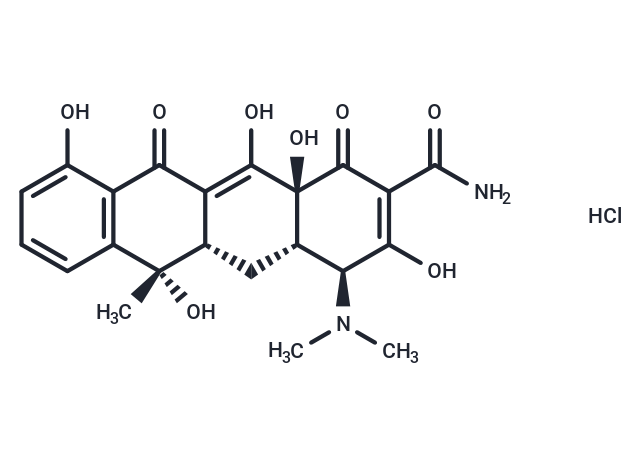 Your shopping cart is currently empty
Your shopping cart is currently empty

Tetracycline hydrochloride (NCI-c55561) is the hydrochloride salt of the tetracycline, a broad-spectrum naphthacene antibiotic produced semisynthetically from chlortetracycline, an antibiotic isolated from the bacterium Streptomyces aureofaciens. In bacteria, tetracycline blocks binding of aminoacyl-tRNA to the mRNA-ribosome complex, thereby inhibiting protein synthesis and bacterial cell growth. Because naturally, fluorescing tetracycline binds to a newly formed bone at the bone/osteoid interface, tetracycline-labeling of bone and fluorescence microscopy may be used to perform bone histomorphometry.

| Pack Size | Price | USA Warehouse | Global Warehouse | Quantity |
|---|---|---|---|---|
| 500 mg | $41 | In Stock | In Stock | |
| 1 g | $59 | - | In Stock | |
| 1 mL x 10 mM (in DMSO) | $45 | In Stock | In Stock |
| Description | Tetracycline hydrochloride (NCI-c55561) is the hydrochloride salt of the tetracycline, a broad-spectrum naphthacene antibiotic produced semisynthetically from chlortetracycline, an antibiotic isolated from the bacterium Streptomyces aureofaciens. In bacteria, tetracycline blocks binding of aminoacyl-tRNA to the mRNA-ribosome complex, thereby inhibiting protein synthesis and bacterial cell growth. Because naturally, fluorescing tetracycline binds to a newly formed bone at the bone/osteoid interface, tetracycline-labeling of bone and fluorescence microscopy may be used to perform bone histomorphometry. |
| In vitro | Tetracyclines are versatile broad-spectrum antibiotics effective against a vast array of organisms, including gram-positive and gram-negative bacteria, as well as atypical pathogens like chlamydiae, mycoplasmas, rickettsiae, and protozoan parasites. Their mechanism of action involves blocking bacterial protein synthesis by hindering the binding of aminoacyl-tRNA to the bacterial ribosome. Specifically, in gram-negative enteric bacteria, tetracyclines enter through OmpF and OmpC porin channels as positively charged coordination complexes, likely involving magnesium ([1]). |
| In vivo | Tetracyclines are utilized for managing infections in various livestock, including poultry, cattle, sheep, and swine, and in aquaculture species such as salmon, catfish, and lobsters[2]. In specific scenarios, such as treating large populations of commercially farmed poultry, these antibiotics may be administered directly through feed, water, or aerosols. Additionally, tetracyclines may serve to promote or enhance growth. |
| Synonyms | Tetracycline HCl, NCI-c55561 |
| Molecular Weight | 480.90 |
| Formula | C22H24N2O8·HCl |
| Cas No. | 64-75-5 |
| Smiles | C[C@@]1([C@H]2C[C@H]3[C@@H](C(=C(C(=O)[C@]3(C(=C2C(=O)c2c1cccc2O)O)O)C(=O)N)O)N(C)C)O.Cl |
| Relative Density. | no data available |
| Color | Yellow |
| Appearance | Solid |
| Storage | store at low temperature,keep away from direct sunlight,keep away from moisture | Powder: -20°C for 3 years | In solvent: -80°C for 1 year | Shipping with blue ice/Shipping at ambient temperature. | |||||||||||||||||||||||||||||||||||
| Solubility Information | DMSO: 126 mg/mL (262.01 mM), Sonication is recommended. Ethanol: < 1 mg/mL (insoluble or slightly soluble) H2O: 88 mg/mL (182.99 mM), Sonication is recommended. | |||||||||||||||||||||||||||||||||||
| In Vivo Formulation | 10% DMSO+40% PEG300+5% Tween 80+45% Saline: 4 mg/mL (8.32 mM), Sonication is recommended. Please add the solvents sequentially, clarifying the solution as much as possible before adding the next one. Dissolve by heating and/or sonication if necessary. Working solution is recommended to be prepared and used immediately. The formulation provided above is for reference purposes only. In vivo formulations may vary and should be modified based on specific experimental conditions. | |||||||||||||||||||||||||||||||||||
Solution Preparation Table | ||||||||||||||||||||||||||||||||||||
H2O/DMSO
| ||||||||||||||||||||||||||||||||||||
| Size | Quantity | Unit Price | Amount | Operation |
|---|

Copyright © 2015-2025 TargetMol Chemicals Inc. All Rights Reserved.